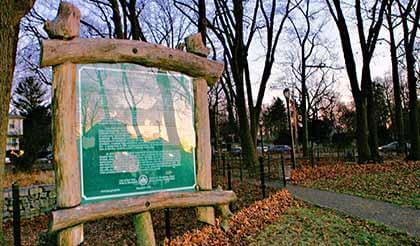By Connor Adams Sheets
Martins Field may soon look less like the average city park and more like the spot now called The Olde Towne of Flushing Burial Ground where an estimated 1,000 people were laid to rest.
The city Parks Department, Borough President Helen Marshall and members of the Olde Towne of Flushing Burial Ground Conservancy met last month at Borough Hall to discuss plans for how to return the site — known until December as Martins Field — to a more appropriate appearance.
The attendees gave their approval to a Parks Department plan to install four 3-foot-tall headstones to replace four marble ones Mandingo Tshaka, the conservancy’s leader from Bayside, said were removed and destroyed by the city in 1935. It would also include the construction of a 6-foot-tall obelisk.
The city introduced a similar proposal six months ago, but Tshaka, conservancy members and other residents concerned about honoring the legacy of those who were buried there, balked at the obelisk design, saying it was not large enough.
Both the Parks Department and Marshall’s office did not return calls for comment.
Proponents of the initiative, which Marshall secured $100,000 in funding for in 2008, said it is necessary to make the monument large enough that it is clearly visible from the street so that the site is treated with the respect the dead deserve and it does not continue to be mistaken for a park.
“One of the things I stressed is that when you ride down Northern Boulevard between Main and Union [streets] and you come up to the Clearview, there’s an obelisk there and you know what the symbol means,” Tshaka said last week. “That’s one of the big problems with the burial ground, that when you go by now you see a park even though signs are up. You see a park, but it’s not a park — it’s a cemetery.”
The site, between 164th and 165th streets along 46th Avenue in Flushing, was used as a pauper’s graveyard for much of the 19th century. Black, native American and poor people were buried there, as were people of any race and social class who were infected with smallpox or cholera. Tshaka said many of them were buried in 6- to 12-inch-deep unmarked graves or even in mass anonymous graves.
He said the conservancy is happy with the movement on the headstone issue, but it will still push for more. The group plans to ask for the city to permanently close the grounds, Tshaka said.
“We’re going to ask that the site be permanently closed, only open on special occasions,” he said. “Because people were bringing their dogs in, they were playing ball and playing on the grass. And those people know they shouldn’t be doing that.”
The plans will be go before Community Board 7’s Parks Committee Sept. 15 at 7 p.m.
Reach reporter Connor Adams Sheets by e-mail at csheets@cnglocal.com or by phone at 718-260-4538.

































